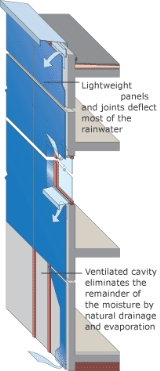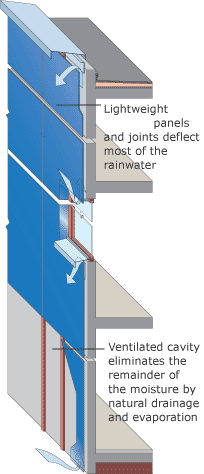
Rainscreen cladding
Encyclopedia

Facade
A facade or façade is generally one exterior side of a building, usually, but not always, the front. The word comes from the French language, literally meaning "frontage" or "face"....
rainscreen
Rainscreen
A rainscreen is the exterior weather-facing surface of an exterior wall detail that stands off from the moisture-resistant surface of the structural backup wall. The rainscreen is the first interruption between conditions that exist on the outside of a walled building and conditions that are...
system which consists of the subframe
Subframe
A subframe is a structural component of a vehicle, such as an automobile or an aircraft, that uses a discrete, separate structure within a larger body-on-frame or unit body to carry certain components, such as the engine, drivetrain, or suspension. The subframe is bolted and/or welded to the vehicle...
and different finishes like cladding panels, brick, ceramic
Ceramic
A ceramic is an inorganic, nonmetallic solid prepared by the action of heat and subsequent cooling. Ceramic materials may have a crystalline or partly crystalline structure, or may be amorphous...
tiles, reconstituted stone boards, ceramic
Ceramic
A ceramic is an inorganic, nonmetallic solid prepared by the action of heat and subsequent cooling. Ceramic materials may have a crystalline or partly crystalline structure, or may be amorphous...
granite
Granite
Granite is a common and widely occurring type of intrusive, felsic, igneous rock. Granite usually has a medium- to coarse-grained texture. Occasionally some individual crystals are larger than the groundmass, in which case the texture is known as porphyritic. A granitic rock with a porphyritic...
based on a natural stone
Rock (geology)
In geology, rock or stone is a naturally occurring solid aggregate of minerals and/or mineraloids.The Earth's outer solid layer, the lithosphere, is made of rock. In general rocks are of three types, namely, igneous, sedimentary, and metamorphic...
, high-pressure laminate
Laminate
A laminate is a material that can be constructed by uniting two or more layers of material together. The process of creating a laminate is lamination, which in common parlance refers to the placing of something between layers of plastic and gluing them with heat and/or pressure, usually with an...
s, composite aluminium
Aluminium
Aluminium or aluminum is a silvery white member of the boron group of chemical elements. It has the symbol Al, and its atomic number is 13. It is not soluble in water under normal circumstances....
panels, metal panels (aluminum, zinc
Zinc
Zinc , or spelter , is a metallic chemical element; it has the symbol Zn and atomic number 30. It is the first element in group 12 of the periodic table. Zinc is, in some respects, chemically similar to magnesium, because its ion is of similar size and its only common oxidation state is +2...
, steel
Steel
Steel is an alloy that consists mostly of iron and has a carbon content between 0.2% and 2.1% by weight, depending on the grade. Carbon is the most common alloying material for iron, but various other alloying elements are used, such as manganese, chromium, vanadium, and tungsten...
), fibre-cement board
Lumber
Lumber or timber is wood in any of its stages from felling through readiness for use as structural material for construction, or wood pulp for paper production....
, or durable exterior woods.
Rainscreen cladding
Cladding (construction)
Cladding is the application of one material over another to provide a skin or layer intended to control the infiltration of weather elements, or for aesthetic purposes....
is the attachment of an outer skin of rear-ventilated cladding to a new or existing building. The system is a form of double-wall construction that uses an outer layer to keep out the rain and an inner layer to provide thermal insulation, prevent excessive air leakage and carry wind loading. The outer layer breathes like a skin while the inner layer reduces energy losses. The structural frame of the building is kept absolutely dry, as water never reaches it or the thermal insulation. Evaporation and drainage in the cavity removes water that penetrates between panel joints. Water droplets are not driven through the panel joints or openings because the rainscreen principle means that wind pressure acting on the outer face of the panel is equalized in the cavity. Therefore, there is no significant pressure differential to drive the rain through joints. During extreme weather, a minimal amount of water may penetrate the outer cladding. This, however, will run as droplets down the back of the cladding sheets and be dissipated through evaporation and drainage.
By insulating the structural wall externally the following benefits are achieved:
- Thermal bridging is somewhat reduced because there are no interruptions caused by floor slabs, however vast thermal bridging is more than likely introduced by means of continuous furring strips. Options do exist to help reduce the amount of thermal bridging introduced or even eliminate the thermal bridging altogether by truly insulating continually across ALL structural members with not breaks or bridges in the insulation except for the finite fasteners used to attach the cladding to the building (negligible by ASHRAE 90.1ASHRAE 90.1ASHRAE 90.1 is a standard that provides minimum requirements for energy efficient designs for buildings except for low-rise buildings. The original standard ASHRAE 90 was published in 1975 and had multiple editions to it in years after...
standards since their thermal bridging effect is so slight) - Temperature fluctuations are minimized due the achievement of higher effective R-values (lower U-Values) therefore creating a much more efficient wall assembly and dramatically reducing the loads on HVAC systems.
- Interstitial condensation is prevented as vapor pressure and wall temperature restricts condensation to the ventilated cavity.
- Heat from the sun is dissipated so that the temperature is dispersed in the cavity and ventilated through openings.
See also
- Double-skin facadeDouble-skin facadeThe Double Skin Façade is a system consisting of two skins placed in such a way that air flows in the intermediate cavity. The ventilation of the cavity can be natural, fan supported or mechanical...
- RainscreenRainscreenA rainscreen is the exterior weather-facing surface of an exterior wall detail that stands off from the moisture-resistant surface of the structural backup wall. The rainscreen is the first interruption between conditions that exist on the outside of a walled building and conditions that are...
- Rainscreen drainage planeRainscreen drainage planeA rainscreen drainage plane is a separation between the veneer and the weather resistant barrier of a rainscreen. It provides predictable, unobstructed path drainage for liquid moisture to drain from a high point of the wall to a low point of the wall the wall detail...
- Cladding (disambiguation)

